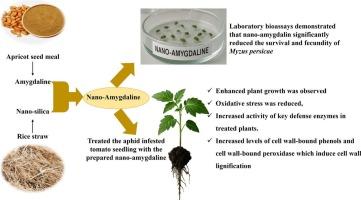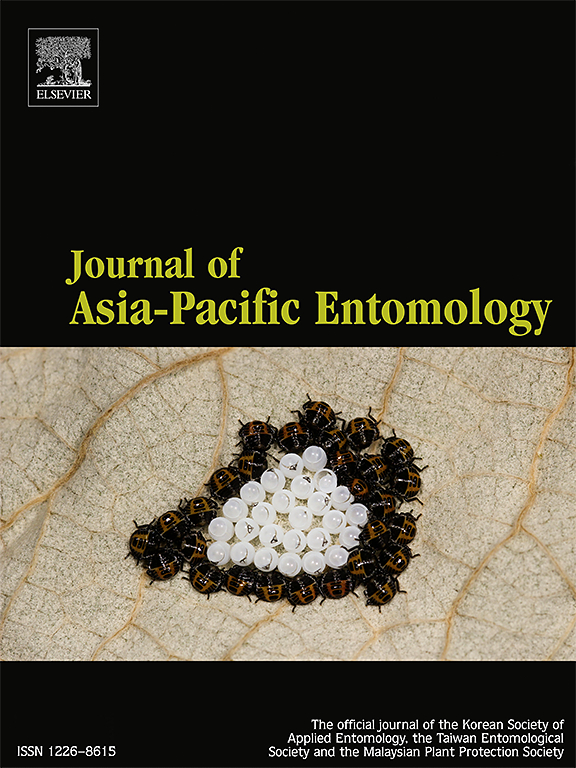农业废弃物纳米配方苦杏仁苷防治蚜虫及诱导番茄抗性机理研究
IF 1.3
3区 农林科学
Q3 ENTOMOLOGY
引用次数: 0
摘要
蚜虫对农业生产力构成重大威胁,因此必须制定生态友好和有效的虫害管理战略。在这项研究中,我们报道了纳米苦杏仁苷(一种从杏籽粕中提取的纳米配方化合物)的制备、表征和杀虫效果,以及它对番茄(Solanum lycopersicum)植物防御反应的影响。从杏籽粕中提取苦杏仁苷,并将其固定在以稻草为原料合成的二氧化硅纳米颗粒上。通过透射电镜(TEM)和傅里叶变换红外光谱(FTIR)证实了纳米苦杏仁苷配合物的成功形成和结构特征。实验室生物测定表明,纳米苦杏仁苷显著降低蚜虫的存活率和繁繁率,最高测试浓度(0.5 mg/mL)使蚜虫存活率降低至12%,繁繁率降低至0.65若虫/雌/天。此外,经纳米苦杏仁苷处理的番茄植株在蚜虫侵染下表现出生长增强和氧化胁迫减弱,过氧化氢和丙二醛水平降低。处理过氧化物酶和多酚氧化酶等防御相关酶活性显著升高。值得注意的是,处理过的植物也表现出细胞壁结合酚类物质和过氧化物酶水平的增加,这表明木质素化的增强是诱导防御机制的一部分。这些发现突出了纳米苦杏仁苷作为一种可持续的、与植物相容的生物农药的潜力,它不仅可以抑制蚜虫种群,还可以加强寄主植物的防御途径。本文章由计算机程序翻译,如有差异,请以英文原文为准。

Nanoformulated amygdalin from agro-waste for aphid control and induction of tomato resistance mechanism
Aphid infestation poses a significant threat to agricultural productivity, necessitating the development of eco-friendly and effective pest management strategies. In this study, we report the preparation, characterization, and insecticidal efficacy of nano-amygdalin—a nanoformulated compound derived from apricot seed meal—against the green peach aphid Myzus persicae, along with its impact on tomato (Solanum lycopersicum) plant defense responses. Amygdalin was extracted from apricot seed meal and immobilized onto silica nanoparticles synthesized from rice straw. The immobilization process achieved an efficiency of 92.4 % after 6 h. Transmission electron microscopy (TEM) and Fourier-transform infrared spectroscopy (FTIR) confirmed the successful formation and structural characteristics of the nano-amygdalin complex. Laboratory bioassays demonstrated that nano-amygdalin significantly reduced aphid survival and fecundity, with the highest tested concentration (0.5 mg/mL) decreasing survival to 12 % and fecundity to 0.65 nymphs/female/day. Furthermore, tomato plants treated with nano-amygdalin under aphid infestation showed enhanced growth and attenuated oxidative stress, evidenced by reduced hydrogen peroxide and malondialdehyde levels. Activities of defense-related enzymes, including peroxidase and polyphenol oxidase, were significantly elevated in treated plants. Notably, treated plants also exhibited increased levels of cell wall-bound phenolics and peroxidase, suggesting enhanced lignification as part of the induced defense mechanism. These findings highlight the potential of nano-amygdalin as a sustainable, plant-compatible biopesticide that not only suppresses aphid populations but also fortifies host plant defense pathways.
求助全文
通过发布文献求助,成功后即可免费获取论文全文。
去求助
来源期刊

Journal of Asia-pacific Entomology
Agricultural and Biological Sciences-Insect Science
CiteScore
2.70
自引率
6.70%
发文量
152
审稿时长
69 days
期刊介绍:
The journal publishes original research papers, review articles and short communications in the basic and applied area concerning insects, mites or other arthropods and nematodes of economic importance in agriculture, forestry, industry, human and animal health, and natural resource and environment management, and is the official journal of the Korean Society of Applied Entomology and the Taiwan Entomological Society.
 求助内容:
求助内容: 应助结果提醒方式:
应助结果提醒方式:


